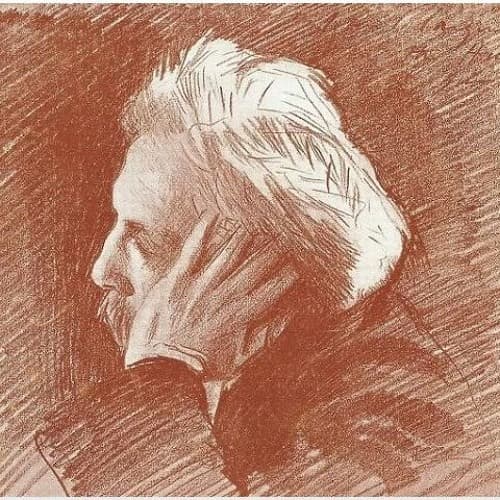175 years ago, Gaetano Donizetti (1797-1848) died in a state of mental derangement due to neurosyphilis. His disease was confirmed by autopsy, and many commentators have “speculated that the composer’s brain disease may have had an influence on his ability to create powerful and unforgettable scenes.” Starting around 1843, Donizetti showed severe symptoms, and he was admitted to an institution for the mentally ill in early 1846.
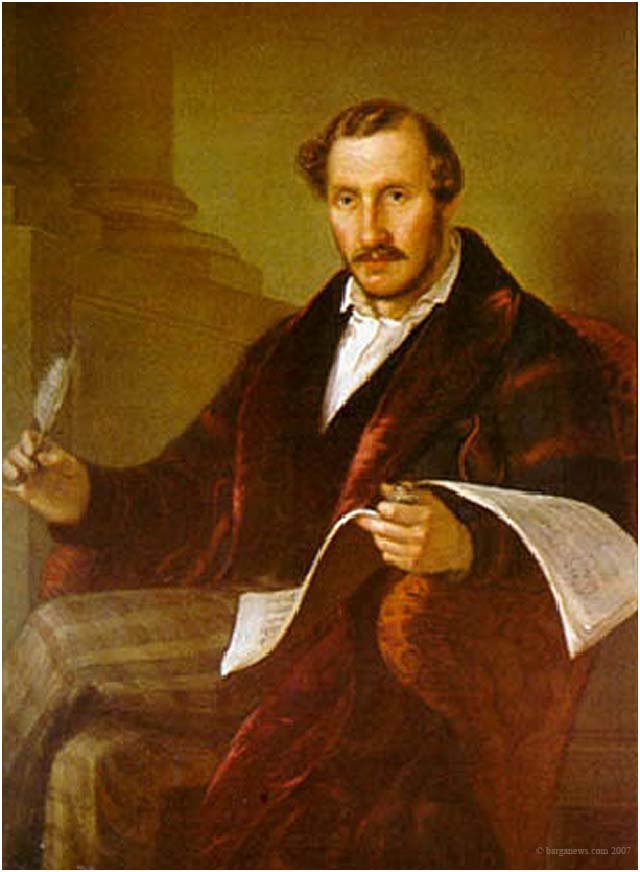
Gaetano Donizetti
Donizetti was one of the most prolific Italian composers of the second quarter of the 19th Century, and he had a “profound influence on the future of Italian opera.” Never mind that Robert Schumann called him “a composer of music for the puppet theatre.” Donizetti composed 70 works for the operatic stage, and to honour this great composer, we have decided to feature the 9 greatest arias written by Gaetano Donizetti. This top 9 is in no particular order, and I basically picked my personal favourites.
L’ Elisir d’amore: “Una furtive lagrima”
Coming in at number 9 is the tenor aria “Una furtive lagrima” from the 1832 opera The Elixir of Love. This sentimental comedy quickly became the most popular opera in Italy and has remained in the repertory ever since. The poor peasant Nemorino is desperately in love with Adina, a beautiful landowner who torments him with her indifference. When he learns of the story of Tristan and Isolde, Nemorino sets out to buy a love potion, which he purchases from a traveling druggist.
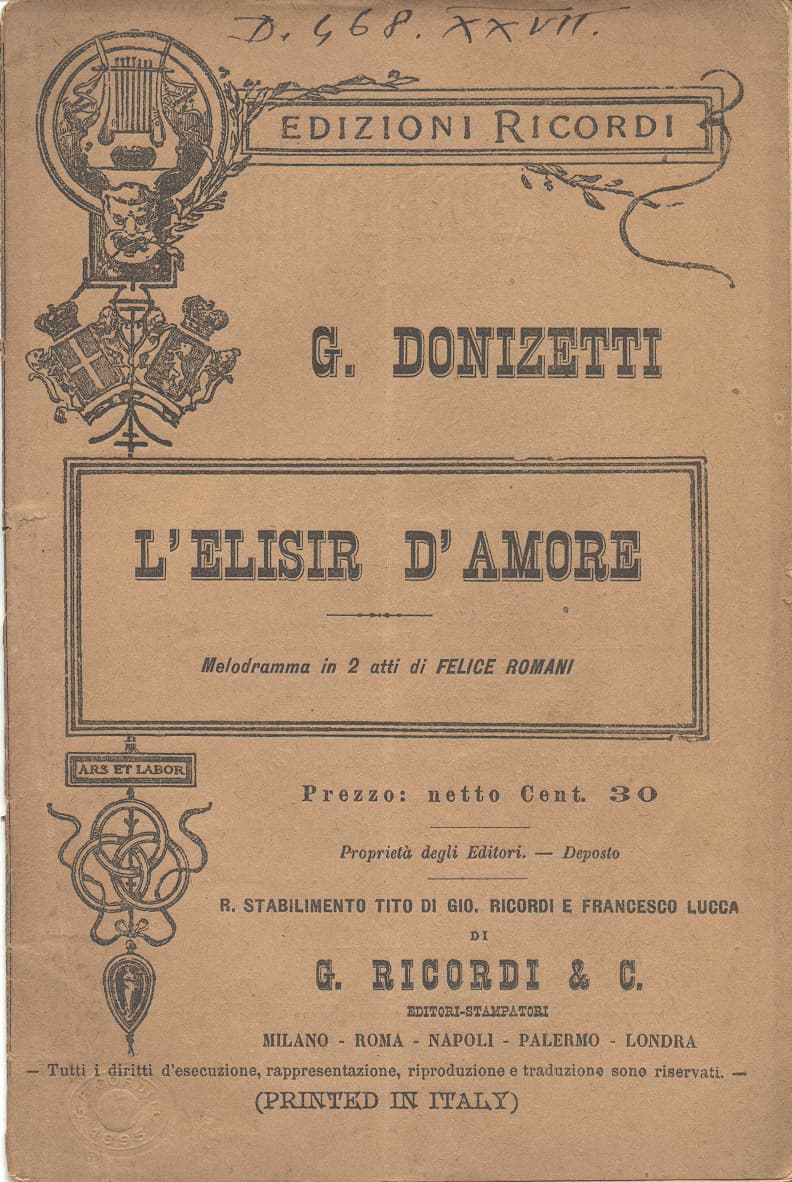
Donizetti: L’ Elisir d’amore
Actually, it’s just a cheap bottle of wine, and while he is fast asleep, Sergeant Belcore proposes to Adina, who accepts. Desperate to buy another love potion, Nemorino signs a conscription contract with Sergeant Belcore. When Adina finds out that Nemorino has spent his last penny on the elixir of love, she realizes that she has loved Nemorino all along. She purchases back his military contract from Sergeant Belcore, and the couple lives happily ever after. Nemorino sings “Una furtive lagrima” (A furtive tear) in Act 2 of the opera when he is convinced that the love potion is working. It is the most popular and crowd-pleasing aria from the opera and a bel canto staple. This supreme musical moment in the opera oozes with Donizetti’s skill of directly conveying the emotional turmoil experienced by Nemorino.
Luciano Pavarotti Sings “Una furtiva lagrima”
Lucia di Lammermoor: “Regnava nel silenzio”
Number 8 on my list is the soprano aria “Regnava nel silenzio” from the first act of Lucia di Lammermoor. Composed in merely six weeks and first produced in Naples in 1835, the opera is set to a libretto by Sir Walter Scott. This tragic love story follows Lucia and Edgardo, members of opposing houses in Scotland. In Act 1, Scene 2, which is set by a fountain at the entrance to the park beside the castle, Lucia is waiting for Edgardo. In her famous aria “Regnava nel silenzio,” (Reigned in the silence) Lucia tells her maid Alisa that she has seen the ghost of a girl killed on the very same spot by a jealous Ravenswood ancestor. The maid tells Lucia that the apparition is a warning and that she must give up her love for Edgardo. The role of Lucia is written for a dramatic coloratura soprano who must also be able to master dramatic expressions at a fortissimo volume.
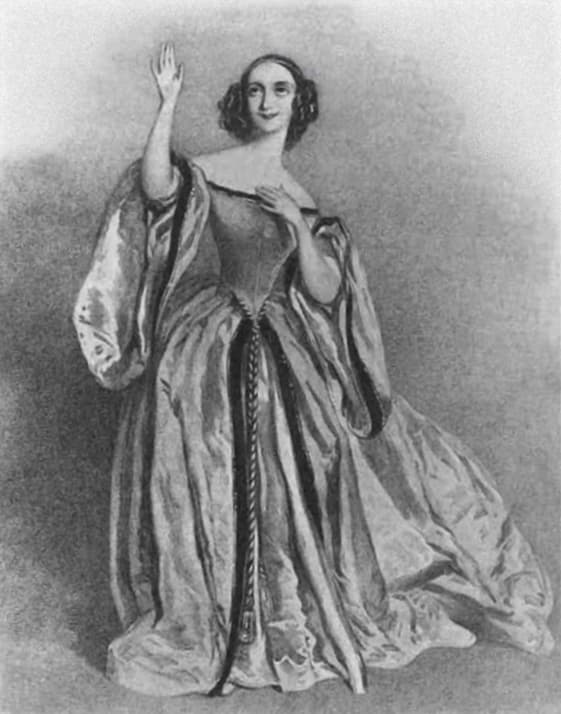
Fanny Tacchinardi Persiani as Lucia in the London premiere of Lucia di Lammermoor
This particular aria became a signature piece for Maria Callas, Anna Netrebko, Luisa Tetrazzini, Edita Gruberova, and Joan Sutherland. Strings and wind instruments prepare the musical canvas, and heavy brass spread a mood of gloom. The clarinet enters with an arpeggiated figure, establishing an atmosphere of fate determined by destiny. The expressive vocal melody emphasizes dramatic words and features beautiful ornaments, and with the final cadenza and orchestra transition, the music moves into the Caballetta “Quanto rapito in estasi” (When enraptured in ecstasy).
Nadine Sierra Sings “Regnava nel silenzio”
La Fille du regiment: “Ah! mes amis,”
Counting down to number 7, I have selected “Ah! mes amis,” (Ah! my friends) from Donizetti’s blockbuster opéra comique La Fille du regiment (The Daughter of the Regiment). The opera was written when Donizetti lived in Paris between 1838 and 1840, and it became an instant success because of this famous aria. “It requires the tenor to sing no fewer than eight high Cs, with a ninth frequently added.”
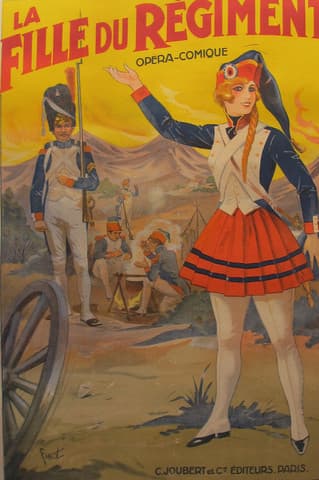
Donizetti’s La fille du regiment, 1910 poster
The story takes place in the Tyrolean Mountains and features Marie, a young woman who was orphaned as an infant and raised by a French army regiment. Marie is unaware of her aristocratic lineage and has fallen in love with the handsome peasant Tonio. The story gets complicated when the Marquise of Berkenfield, actually a relative, arranges the marriage between Marie and Scipion, nephew of the Duchess of Krakenthorp. Marie is just about to sign the marriage contract when Tonio comes to the rescue. The noble guests are shocked to learn that Marie was a canteen girl, but they change their minds when she describes her upbringing, telling them that she can never repay the debt she owes the soldiers. The marquise is so moved that she gives her permission to marry Tonio. Everyone joins in a final “Salut à la France.” Donizetti’s masterful gift for melody and his terrific sense of theatre is evident in this famous aria, where Tonio rejoices, “Here I am, a husband and a military man.” The high Cs, making this aria superhumanly difficult and popular, clearly emphasize this sense of ecstasy.
Juan Diego Flórez Sings “Ah! mes amis”
Linda di Chamounix: “O luce di quest’anima”
Counting down to number 6, I give you the soprano opera “O luce di quest’anima” (Oh light of all my being) from Donizetti’s 1842 operatic melodrama Linda di Chamounix. The opera was Donizetti’s first success in Vienna, and it tells the story of a beautiful young girl who falls in love with Carlo, a Viscount pretending to be a poor painter. When she moves to Paris to live in a beautiful apartment provided by Carlo, she finds out that he is getting married to another woman. With her father overwhelmed by shame at her conduct, she loses her mind. Eventually, Carlo does not go through with the wedding and comes back to marry her, restoring her sanity and her reputation.

Donizetti: Linda di Chamounix
The character of Linda has been described as “one of those pure, sweet unsophisticated creatures who exist only on the stage, and possibly only in opera.” Trying to keep a rendezvous with her beloved Carlo, “Linda sings like a bird with high notes of considerable power and agility.” The aria provides a clear testament to Donizetti’s skill at musical characterization.
Olga Peretyatko Sings “O luce di quest’anima”
Don Pasquale: “So anch’io la virtu magica”
The opera buffa Don Pasquale, which was first staged on 3 January 1843 by the Théâtre-Italien at the Salle Ventadour, is “generally regarded as the high point of the 19th century opera buffa tradition, in fact, marking its ending.”
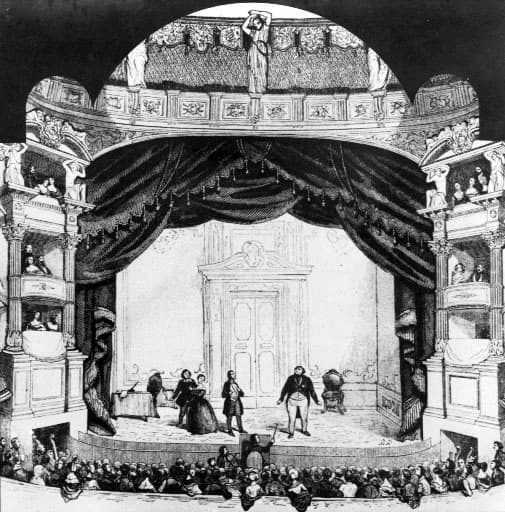
Premiere of Donizetti’s Don Pasquale in 1843
At the centre of the story is the old bachelor Don Pasquale, who wants to marry in order to punish his rebellious nephew Ernesto. Ernesto is in love with the young widow Norina, but with his uncle’s impending marriage, he will have no inheritance and will be unable to marry her. What follows is a complicated opera buffa plot of impersonation, cross-dressing, and a happy end. The aria “So ancho’io la virtu magica” (I also know your magical virtues) comes from the end of the first act, and when Norina is reading a passage about love in a novel she starts singing. When she is approached with a plan to fool Don Pasquale into bending the will of a woman, she resolutely asserts her powers to make a man do as she pleases. A scholar writes, with this cabaletta, Norina speaks directly to the audience. By hearing her out, we become her accomplices. Norina does not play the scene to us but with us.”
Anna Netrebko Sings “So ancho’io la virtu magica”
Anna Bolena: “Al dolce guidami”
Donizetti scored his first international success with Anna Bolena premiered at the Teatro Carcano in Milan on 26 December 1830. It was an overwhelming success, and for opera scholars “it was a game changer. Although he was acutely aware of the influence wielded by Bellini, Anna Bolena was “a logical extension of directions that Donizetti had already explored… it is more a product of a self-motivated maturation than had been recognized.”
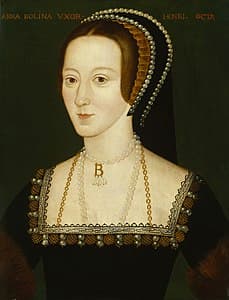
Anne Boleyn
It is one of four operas by Donizetti dealing with the Tudor period in English history, and it tells the story of Anne Boleyn, second wife of England’s King Henry VIII. When the king gets bored of his first wife and numerous mistresses, he falls in love with Anne Boleyn and makes her his second wife. However, he quickly tires of her and chooses Anne’s confidante Jane Seymour as his new favourite. As the king is eager to marry Jane Seymour, Anne has been falsely accused of adultery and sentenced to death. In the her soulful aria “Al dolce guidami castel natio” (Lead me to the dear castle where I was born), Anne bids her maids not to weep but instead, driven mad by fear and betrayal, thinks back nostalgically to the peace of her youth. Supported by woodwinds, a highly decorated vocal line repeatedly circles back upon itself, “mirroring Anna’s obsessive thoughts.” It is a lament set, surprisingly, in the major mode, one that will soon erupt into a violent cabaletta against the bridal couple.
Montserrat Caballe Sings “Al dolce guidami”
La Favorita: “O mio Fernando”
At number 3, let’s take a listen to “O mio Fernando” (My dear Fernando) from the 1840 opera La Favorita (The Favourite). Against the background of the Moorish invasions of Spain and a power struggle between church and state, the plot focuses on a love triangle involving the King of Castile, Alfonso XI, his mistress Leonora (the favourite), and her lover Fernando.
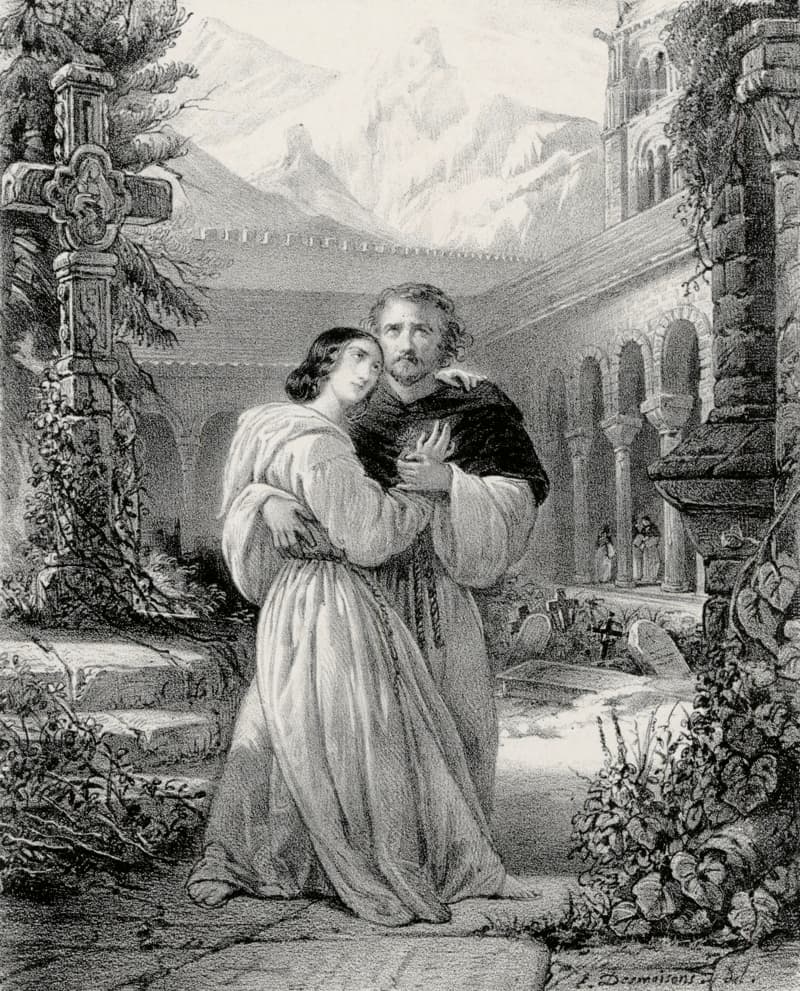
Gilbert Duprez & Rosine Stoltz in Donizetti’s La Favorite
The story opens at the Monastery of St. James, with Fernando telling his superior that he is in love with a mysterious woman and he wished to leave the monastery. Fernando does find Leonora, but she tells him that they cannot marry and must never meet again. Fernando receives a commission for the army, and the King is happy to get rid of him. Alfonso XI wants to divorce his wife and marry his mistress Leonora, but she is accused of having a lover, which she does not deny. When Fernando returns from War, the King grants him a wish, and he asks for Leonora’s hand in marriage. The King realizes what is going on and arrests Leonora after Fernando learns the truth about the mistress relationship. In the end, Fernando is preparing to enter a new religious life, and Leonora dies in his arms after earning his forgiveness. In Act III, Leonora is left alone to confront her shame and weigh the chances of Fernando forgiving her in the double aria “O mio Fernando.” According to scholars, “it stands as one of the great monologues of French opera.” Donizetti, in the usual fashion, tailored this aria to the “particular vocal aptitude of his first Leonora, Rosine Stoltz.”
Elina Garanca Sings “O mio Fernando”
L’Elisir d’amore: “Quanto e bella quanto e cara”
My top 2 personal choices are taken from operas that we have already explored so let’s start the countdown with my number 2, “Quanto e bella quanto e cara” (How beautiful she is, how dear she is) from L’Elisir d’amore. This famous aria is sung in the first act when Nemorino is declaring his love for Adina. It is both a love song and a lament.
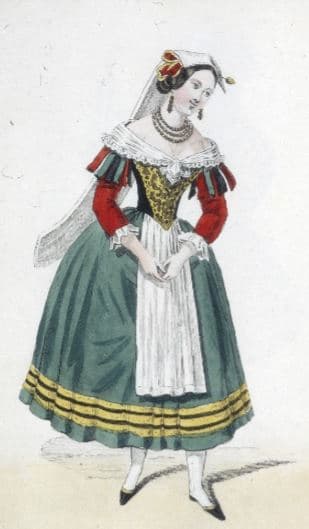
Adina in Donizetti’s L’Elisir d’amore
The aria opens with flutes playing a simple melody. Flutes have long been associated with pastoral music, and in this case, it signals that Nemorino is a poor and simple peasant, with the lyrical music reflecting his humble status. The cavatina-like nature of the aria, scored in the pure key of C major, quickly suggests the amorous qualities of the encounter. But when the music switches to the minor key, we hear a miniature lament within this love song. Towards the end of the aria, Nemorino repeats the line “I can’t inspire any affection in her heart” over and over, and as the pitch rises we get the impression that he is truly desperate.
Luciano Pavarotti Sings “Quanto e bella quanto e cara”
Lucia di Lammermoor: “Il dolce suono”
And thus we have arrived at my personal number 1, the aria “Il dolce suono” (The Sweet Sound) from Lucia di Lammermoor. It is the opening recitative of a scena and aria taken from Act III, and it is commonly known as “the mad scene.” Lucia descends into madness, and on her wedding night, while the festivities are still being held in the Great Hall, she stabs her new husband, Arturo, in the bridal chamber. Dishevelled, unaware of what she has done, she wanders in the Great Hall, recalling her meetings with Edgardo and imagining herself married to him. Originally, Donizetti intended the aria to be accompanied by the eerie sound of the glass harmonica, but normally we will hear a flute in performance today.

Lucia di Lammermoor: “Il dolce suono” in movie Fifth Element
The “Mad Scene” is found in the quirky science fiction blockbuster The Fifth Element, set in the 23rd century and featuring an intergalactic struggle for the survival of planet Earth. When the hero Korben Dallas, played by Bruce Willis attends an opera recital on a luxury liner cruising through outer space, he is in for a major surprise! The soprano, Diva Plavalaguna is a statuesque blue alien who launches into an eerie rendition of the aria. The otherworldly voice actually belongs to Albanian singer Inva Mula, and just has a listen to the digitally manipulated cadenza at the end of the aria!
For more of the best in classical music, sign up to our E-Newsletter
Inva Mula sings “Il dolce suono” (The Fifth Element)
(Watch this video if the video above is unavailable in your region.)

